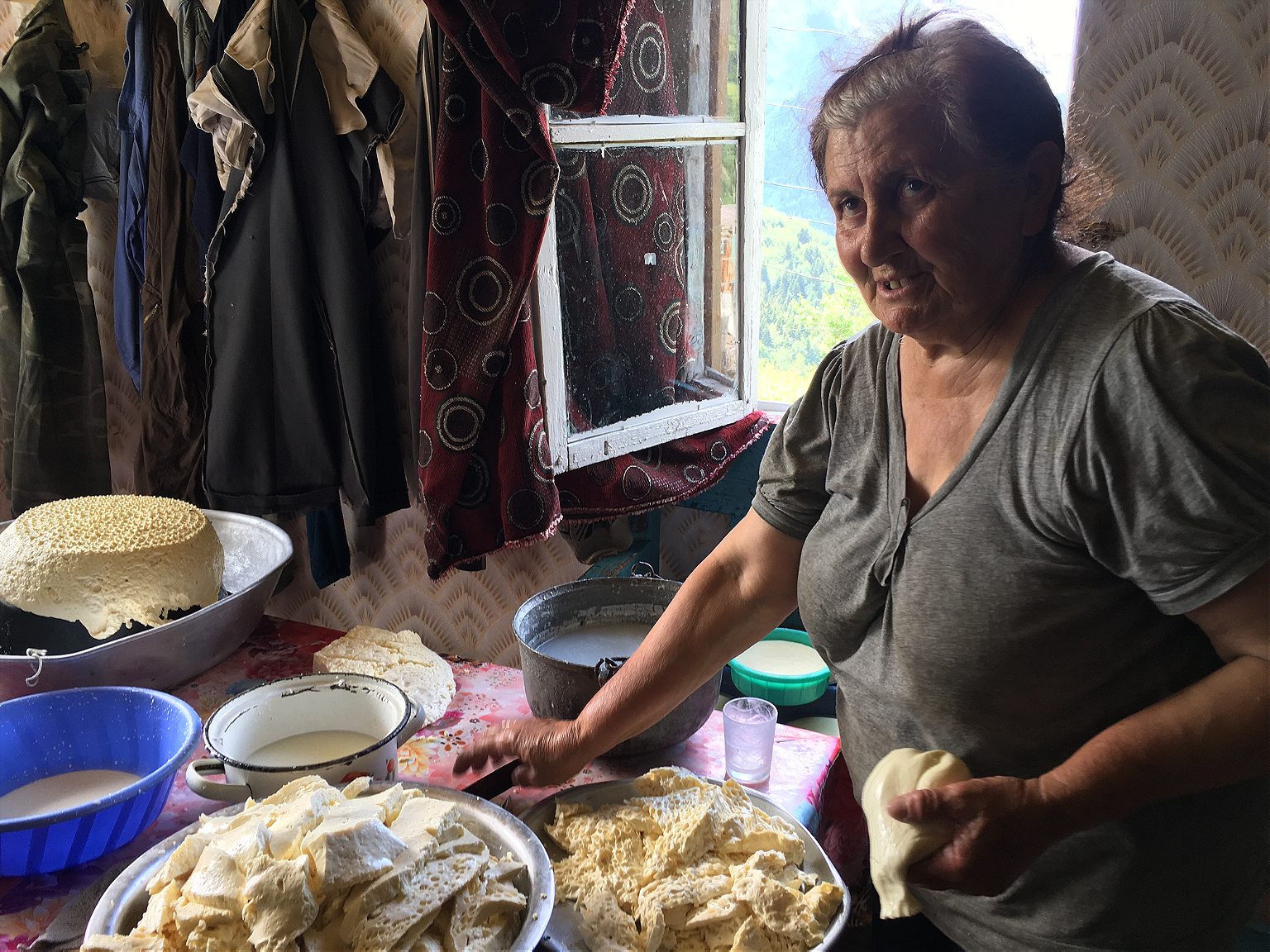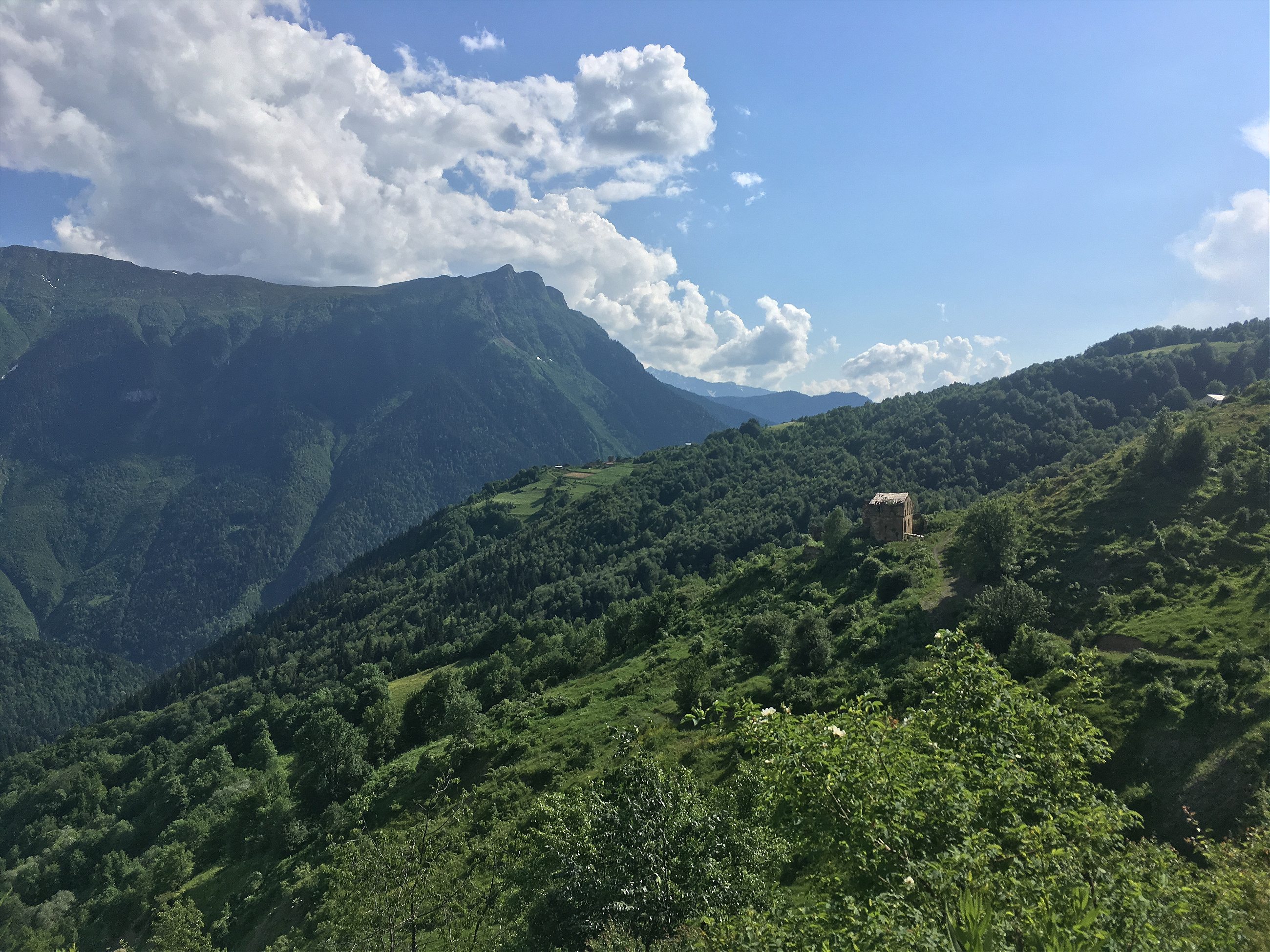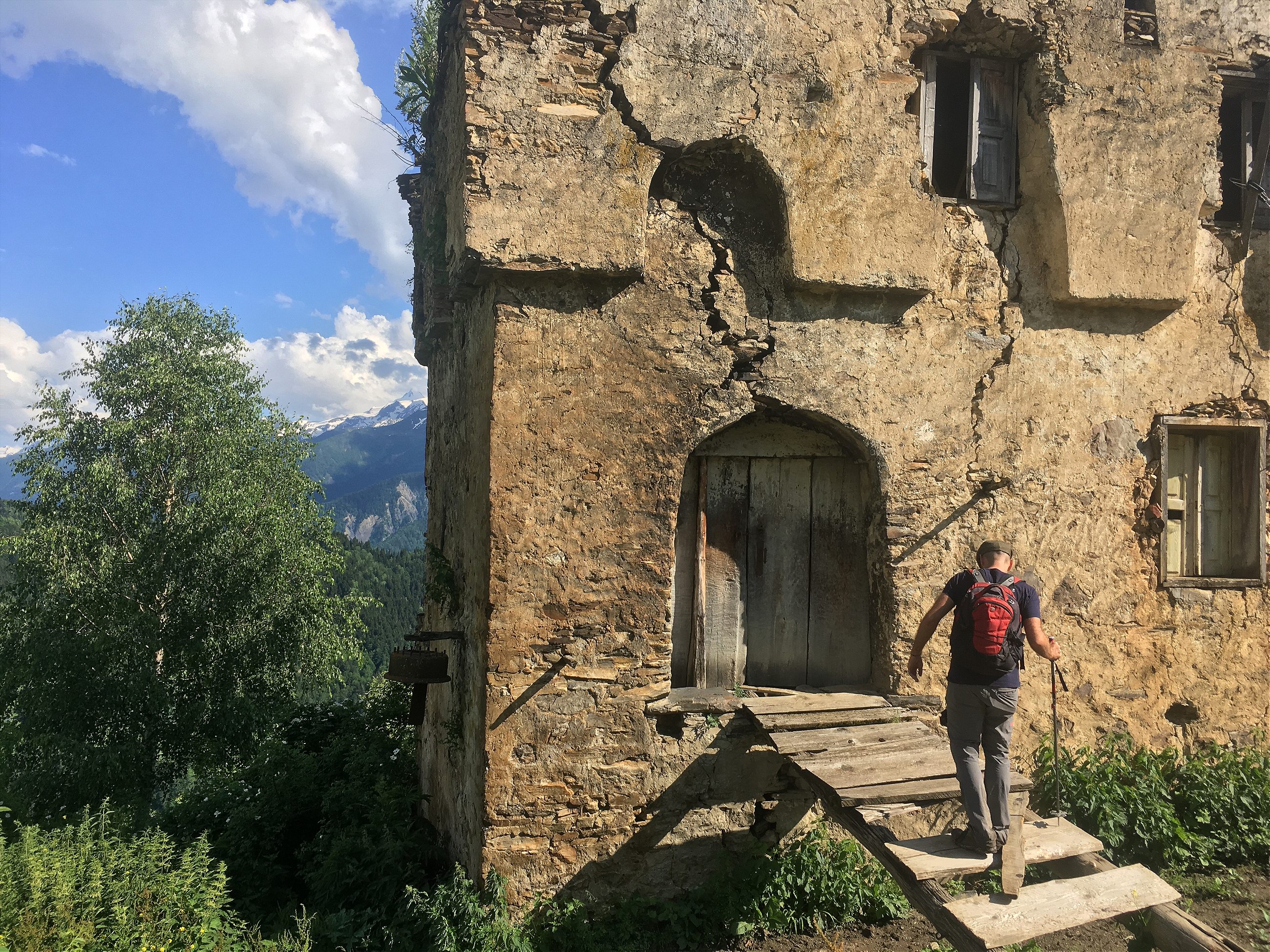A remote region of Georgia is hoping tourism can save a vanishing culture.
KICHKULDASH, GEORGIA—
It’s a bright, hot day in the nearly abandoned village of Kichkuldash, and its last remaining citizens are making lunch. Maro, a stout, stern-faced woman in her 60s, is preparing great piles of cheese beside a wood-fire oven.
Valeri, her husband, is already on the booze. He’s stirring up a 34-gallon barrel of chacha, a home-brewed brandy, somewhere around 75 percent alcohol by volume. His nose is already turning a traffic-light red. Outside on the porch, a bear skin hangs drying. Valeri hunted it, illegally, himself.
What does bear taste like, I ask him.
“A bit like mountain goat,” he replies, taking another swig.
Valeri and Maro have one of the world’s most spectacular backyards. Their small complex of houses and barns backs onto the sweeping foothills of the Caucasus Mountains. The view has been theirs alone since 2011, when their last neighbor left town. This is Svaneti, a rugged region of Georgia whose emerald green valleys are carved by rivers that snake off toward the Russian border.
Its people, the Svan, once welcomed hikers and thrill-seekers from all over the Soviet Union. Georgia was one of the USSR’s premier holiday destinations. But post-Communist political and economic turmoil has emptied towns like Kichkuldash. Svan culture, millennia old, is in danger of vanishing as well.

Svaneti has been an outdoor adventurer’s mecca for centuries. It is situated on the southern slopes of the Greater Caucasus range, whose highest peak, Shkara, towers on the horizon. Just north of the Russian border is Mount Elbrus, Europe’s tallest mountain.
During the Communist era, Georgia was known as the “Riviera of the Soviet Union.” It welcomed 3 million visitors annually. People from all over came to traipse Svaneti’s trails, many of which were created centuries ago by intrepid cattle farmers. They left a network of concrete turbazas—tour bases—littered along the countryside.
But a booming tourism industry seemed unlikely immediately after Georgian independence in 1991. Financial mismanagement and political division led to wars with the breakaway regions of South Ossetia and Abkhazia. The country’s first post-independence president was ousted in a violent coup d’etat. Tensions with Moscow led Russia to hike energy prices, leaving the Georgian economy in tatters. By 2000, only 387,000 people visited Georgia.
Valeri, whose broad shoulders and handlebar mustache give him the appearance of an Eastern European Charles Bronson, joined the Red Army in 1972 but never saw battle. His brother was killed in the Abkhazian conflict in 1993, which cleaved away a huge chunk of Georgia. Abkhazia remains a de facto independent nation, propped up by the Kremlin and off-limits to its former compatriots.
It was in the wake of the war, when many fled Abkhazia, that Kichkuldash reached its highest population: around 50. In the winter Valeri made his own skis—he still does—and spent entire days with friends whizzing up and down the snow-covered slopes beside his home.
This remote region is unique from the rest of Georgia. Their Svan language, though written in the Georgian script, is completely different from the country’s national tongue. It contains few vowels and is notoriously complex. “When you can hear the river running,” one local jokes to me, “you can understand Svan.”

They also practice their own religion, a fusion of early Christianity and paganism. The day we met, Valeri showed me his family church, a tiny, fourth-century hut littered with sacrificial bones and notched, wooden staffs, each of which represents a local family.
Many say the faith has been deliberately squashed by Georgia’s all-powerful Orthodox Church. More than 80 percent of Georgians identify with Orthodoxy and its patriarch, Ilia II, is one of the country’s most powerful men. Ilia’s priests, who drive about in cities like Tbilisi, the capital, in church-bought black SUVs are, to say the least, zealous: They often attack minority groups such as LGBTQ activists.
Unsurprisingly, the Orthodox Church also has little tolerance for the Svan faith. Throughout the region, new Orthodox churches, with their distinctive pointy cupolas, have sprung up. A recent festival of Svan culture arranged by a Norwegian visitor was canceled following threats from local church leaders.
Valeri, whose drunken piety extended to donning a pair of ram’s horns and walking about making animal noises, has little time for fatalism. But he does worry that if more people leave the villages, their faith will disperse and die. “We understand the rules of the religion, but no one else does,” he says.
The terrain around Kichkuldash, which is about a 30-minute drive, and as long a hike, from the main regional town of Mestia, is breathtaking. The single, two-mile mud track connecting it with the nearest road drops off into a bottle-green gorge of trees and high grass that bottoms out at a rushing river.
The snowy peaks of the Caucasus are visible behind. It’s hard to believe anyone want to leave here, Valeri tells me. With no tourist money to live off of, however, they’ve been left with no choice. “The young kids don’t want to live in a village any more,” he says. “Life is really hard. Young people don’t feel compelled to stay.”
The government have done almost nothing to connect Valeri and Maro with the rest of Svaneti. The only bridge linking the village to homes across the valley was built by Valeri himself. The region’s residents hope an influx of tourism could persuade politicians to rebuild old infrastructure; perhaps, even, to renovate the turbazas.
Those who do make it to the region are richly rewarded. Not only is Svaneti naturally gorgeous but it is full of ancient towns, many of which are still ringed by their iconic ninth-century koshki—defensive towers—which are UNESCO World Heritage Sites. They have helped repel a host of marauding armies throughout history, including Macedonians, Mongols, Persians, and Turks.
The UNESCO designation has, however, done little to save dozens of towers that lay derelict all over Svaneti. Lahiri is a town of a few dozen people, almost all of whom work the surrounding land. The town used to have 19 koshki, a passing farmer tells me. Now only 14 remain. This is the most beautiful village around,” he says. “But no one comes here.”
Around an hour from Kichkuldash, I meet Nino, a 54-year-old woman who lives alone in a quaint wood-paneled house. Her village now consists of little more than her own home, a few fields, and a crumbling koshki.
Nino grows potatoes, beans, and onions beside a giant jagged valley. The view is breathtaking: a lone tower stands watch, dwarfed by the verdant hills heading off towards the Russian Kabarnino–Balkar Republic. Nino knows it is stunning. But these days, she thinks less about her spectacular view, and more about survival. Her husband died in 1993. Her two sons would prefer to live in Svaneti, she says, “but there’s not a lot of work.” Tourism would be “better for everyone,” she adds, “and there’ll be more fixing up of roads and stuff.”
Nino’s house, standing alone on a matted plateau, looks like an Alpine chalet, a hiker’s dream. But she doesn’t think she will benefit directly from added tourism: She has no bathroom in her home so travelers would be unlikely to stay there. “But I think generally it’s a good thing,” she says.
One group of international bushwackers is trying to help the fledgling tourism push by creating a “Transcaucasian Trail,” a single hiking trail that would stretch nearly a thousand miles and make it easier for visitors to take in the region’s natural splendor. American Austin Cowley, a former Peace Corps volunteer in Georgia, got involved in creating the trail more for the cultural aspect of the route than its surroundings.
“Building a trail through Kichkuldash might change it,” he tells me at his team’s small Mestia headquarters. “But it might also contribute to these villages having some way for people to stay in them, make money and get by. If no one contributes to this village, that’s going to be it.”

Mestia, along with the rest of Georgia, has enjoyed a relative boom in tourism the past few years, thanks to a host of hotels and a tiny but smart new airport. (In 2013, visitor numbers topped 5 million nationally.) It’s also a hub for local cuisine, including the ubiquitous khachapuri, an unrepentantly calorific cheese-filled bread. Also on the menu is sweet and strong Georgian wine, whose alcoholic effects, like chacha, are swift and unforgiving.
But most people confine themselves to the town. Homestays are a rarity. Few visitors encounter smaller villages, and even fewer Svan culture. And it’s not necessarily from lack of trying. Snow can be many feet high in May and hiking routes routinely disappear. I joined what I thought was a punishing three-hour trek this summer, following a centuries-old cattle path that climbed through mud and rocks past a violently zigzagging river. Jeff Haack, an American trail organizer, chuckled. “This is pretty easy,” he said.
The group, which has crowdfunded a little over $10,000 for the project, hopes to help push tourism in Svaneti. Each day the team heads out along a different trail, geomapping and noting spots for signposts, where water should be bridged or where routes have to be cleared.
It became clear early on that their initial plan, to go for the entire route at once, would be too ambitious. Now the team has broken it up into separate trails—east to west and north to south—which comprise 14 sections. Each one passes through a separate region in a part of the world where dozens of wildly different cultures sit side-by-side.
Beyond Georgia, the team will inevitably hit trouble. The Caucasus has been politically dissected since the Soviet Union’s dissolution. Abkhazia and South Ossetia are out of bounds. So, perhaps, is Azerbaijan, whose autocratic government is wary of foreign travelers. Azerbaijan is itself locked in a 28-year-old war with neighboring Armenia over the disputed territory of Nagorno–Karabakh.
VALERI KNOWS HIS PEOPLE STAND ON THE EDGE OF A CULTURAL ABYSS
Valeri would love to meet more travelers. Tourism “will bring people, which will convince people to stay,” he says. For him, it would mean a chance to reunite his family: In winter, Maro and their three children stay at a property in Tbilisi. Valeri remains, hunting and skiing and drinking his chacha alone for months.
“How do you keep going?” he asks me, pre-empting my question and pressing for yet another alcoholic toast. (Georgian meals are often punctuated with toasts to anything from peace and prosperity to passing cats.) “The family keeps me going, to see family.” Sometimes he goes out hunting, he adds. If not, he puts away the skis, drinks some chacha, and goes to bed.
I ask him how long it takes him to get through one of the 34-gallon barrels. He laughed. “You just drink and drink and drink,” he says, raising a glass. “You don’t really quantify it.”
Valeri knows his people stand on the edge of a cultural abyss. For that, he feels a deep sense of responsibility as well as hope that tourism can deliver the Svan from destruction. “We are the gatekeepers of Svan culture,” he tells me. “We’ve got to take care of it.”
